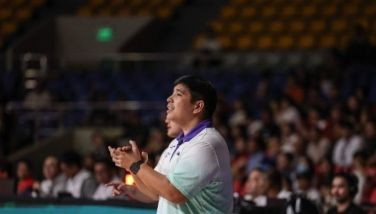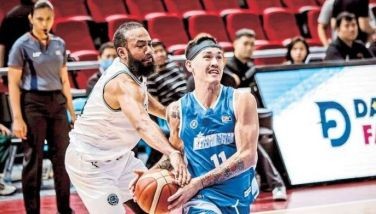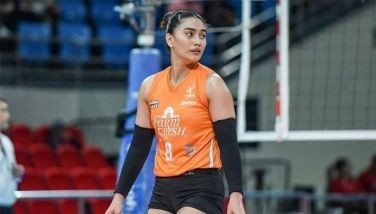Fil-Am gray
November 25, 2002 | 12:00am
The Senate is poised to conduct an inquiry into the true status of several Filipino-American players in the Philippine Basketball Association. But the issues are not related to whether or not the players in question are black or white, African-American or Caucasian. The question lies in the gray area of the rules of the game.
Basically, the quest of Senator Robert Barbers is to determine the authenticity of the paperwork submitted by the Fil-Ams in question. There are at least nine reportedly on his list. The inquiry was originally slated for middle of the year, but was moved until after the Asian Games upon request of the PBA, so as not to derail the Philippine team’s preparations. Nine Fil-Ams were on the RP team roster to Busan. As the joke goes, did some of them acquire Filipino blood from a mosquito bite?
But let’s go back to the beginning. The Philippine Basketball Association’s Fil-Am explosion did not take place until around the time of the birth of the Metropolitan Basketball Association five years ago. At the time, the MBA planned to have a maximum of two Fil-Ams per team, and would gradually phase them out, leaving the field clear for local talent to shine. Incidentally, Barbers was part-owner of the Suriago franchise in the MBA, and never believed in employing Fil-Am players. The PBA, meanwhile, went in the opposite direction, having no clear limits to the number of Fil-foreign players per team, as long as they could prove that one parent was Filipino at the time of their birth.
There have been complications, of course. First of all, the year of birth was governed by different constitutions. That is one reason why Coca-Cola’s Will Antonio could play in the PBA and his older brother, Stephen, could not. Another issue is whether or not the players’ parents were still Filipino at the time of their birth. Even if, let’s say, a player’s mother was originally Filipino, if she attained American citizenship (or citizenship of any other country) before her son was born, that makes her son irreversibly foreign, and disqualifies him from playing here professionally.
Another twist would be the parent’s birth records. If, as in some cases, the Filipino parent was born in a far-flung town without an existing municipal hall, then formal birth records would be hard to come by. And, commonly, fires obliterate all records, making it diffcult to reconstruct.
The player would also have to prove his relationship with deceased relatives. If all they have are papers, they will need corroborative testimony from living kin. This is one area where Barbers and Sen. John Osmena hope to nail fraudulent Fil-Ams.
But going back even further, if the PBA opened its doors completely to foreign players (like the NBA), then there would theoreticaly be no problem, at least not on paper. In the Australian National Basketball League (where former Crispa import Al Green and former Pepsi import Lanard Copeland became superstars), they even go to the extent of allowing imports to be naturalized to serve their individual teams longer.
But of course, the PBA is merely allowing Filipino players born of mixed parentage their right to make a living here. However, the kink is whether or not some inventive agents have managed to dupe the PBA with false papers, which is not entirely implausible, considering the amounts of money involved with becoming a superstar player.
Would the PBA consider imposing limits on teams with increasing numbers of Fil-Am players? A similar situation was faced by the US educational system. Asian immigrants and their children started to outperform American students so much that the federal government decided to cut down on scholarships for foreign students, and impose more stringent rules. It seemed unfair, but it was the only way to stem the growing negative sentiments of the American public.
Perhaps it is time that the public make its true sentiments regarding Fil-Am players known. After all, we ooh and aah whenever they play, but do we really approve of them being here on the whole, and to what extent?
The PBA has to make a more definite stand on this issue, and clarify its intentions in greater details. To the extent that it wants to protect the rights of local-bred players, it should say so. And to the extent that it wants to protect the rights of players whose foreign birth was not their fault, it should also say so.
This week’s episode of The Basketball Show will be on IBC-13 at an earlier timeslot of 12:00 noon to make way for a major billiards tournament. It will resume on its regular 4:00 p.m. timeslot next Saturday. We will also be launching contest wherein you may give text feedback and choose your Most Valuable Player for 2002.
You may reach us through [email protected] or [email protected]
Basically, the quest of Senator Robert Barbers is to determine the authenticity of the paperwork submitted by the Fil-Ams in question. There are at least nine reportedly on his list. The inquiry was originally slated for middle of the year, but was moved until after the Asian Games upon request of the PBA, so as not to derail the Philippine team’s preparations. Nine Fil-Ams were on the RP team roster to Busan. As the joke goes, did some of them acquire Filipino blood from a mosquito bite?
But let’s go back to the beginning. The Philippine Basketball Association’s Fil-Am explosion did not take place until around the time of the birth of the Metropolitan Basketball Association five years ago. At the time, the MBA planned to have a maximum of two Fil-Ams per team, and would gradually phase them out, leaving the field clear for local talent to shine. Incidentally, Barbers was part-owner of the Suriago franchise in the MBA, and never believed in employing Fil-Am players. The PBA, meanwhile, went in the opposite direction, having no clear limits to the number of Fil-foreign players per team, as long as they could prove that one parent was Filipino at the time of their birth.
There have been complications, of course. First of all, the year of birth was governed by different constitutions. That is one reason why Coca-Cola’s Will Antonio could play in the PBA and his older brother, Stephen, could not. Another issue is whether or not the players’ parents were still Filipino at the time of their birth. Even if, let’s say, a player’s mother was originally Filipino, if she attained American citizenship (or citizenship of any other country) before her son was born, that makes her son irreversibly foreign, and disqualifies him from playing here professionally.
Another twist would be the parent’s birth records. If, as in some cases, the Filipino parent was born in a far-flung town without an existing municipal hall, then formal birth records would be hard to come by. And, commonly, fires obliterate all records, making it diffcult to reconstruct.
The player would also have to prove his relationship with deceased relatives. If all they have are papers, they will need corroborative testimony from living kin. This is one area where Barbers and Sen. John Osmena hope to nail fraudulent Fil-Ams.
But going back even further, if the PBA opened its doors completely to foreign players (like the NBA), then there would theoreticaly be no problem, at least not on paper. In the Australian National Basketball League (where former Crispa import Al Green and former Pepsi import Lanard Copeland became superstars), they even go to the extent of allowing imports to be naturalized to serve their individual teams longer.
But of course, the PBA is merely allowing Filipino players born of mixed parentage their right to make a living here. However, the kink is whether or not some inventive agents have managed to dupe the PBA with false papers, which is not entirely implausible, considering the amounts of money involved with becoming a superstar player.
Would the PBA consider imposing limits on teams with increasing numbers of Fil-Am players? A similar situation was faced by the US educational system. Asian immigrants and their children started to outperform American students so much that the federal government decided to cut down on scholarships for foreign students, and impose more stringent rules. It seemed unfair, but it was the only way to stem the growing negative sentiments of the American public.
Perhaps it is time that the public make its true sentiments regarding Fil-Am players known. After all, we ooh and aah whenever they play, but do we really approve of them being here on the whole, and to what extent?
The PBA has to make a more definite stand on this issue, and clarify its intentions in greater details. To the extent that it wants to protect the rights of local-bred players, it should say so. And to the extent that it wants to protect the rights of players whose foreign birth was not their fault, it should also say so.
You may reach us through [email protected] or [email protected]
BrandSpace Articles
<
>
- Latest
- Trending
Trending
Latest
Trending
Latest
Recommended































